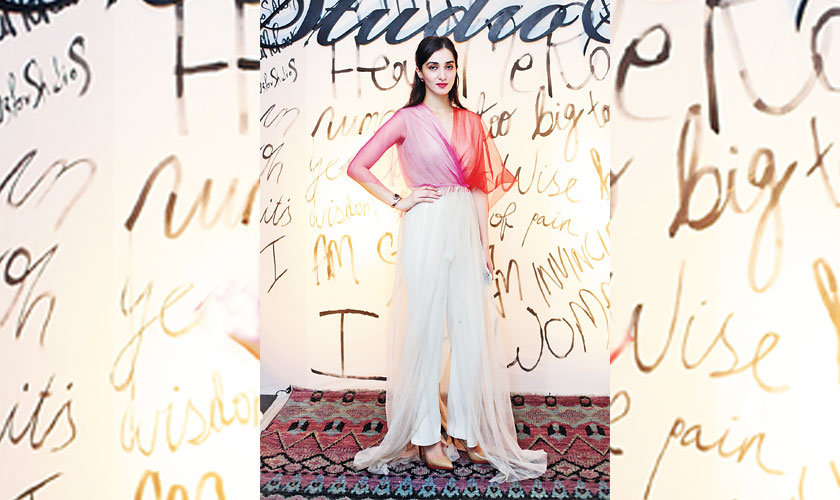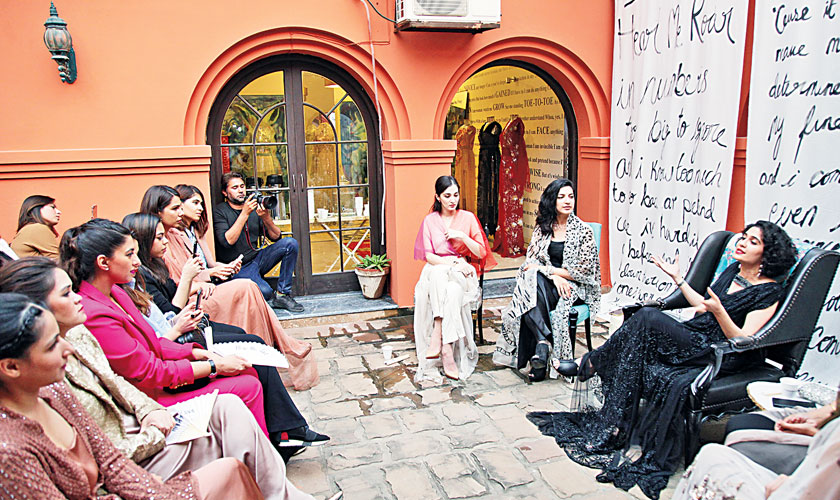Seher invited a group of contemporary female artists – Risham Syed, Aroosa Rana and Saba Khan, moderated by writer and
feminist Mina Malik-Hussain – to the evening and they got the conversation rolling.
feminist Mina Malik-Hussain – to the evening and they got the conversation rolling.
INSTEPREport
Seher Tareen of Studio S launches her A/W collection, Hear Me Roar, with a private viewing followed by a talk by several feminists.
Lahore: Feminism in fashion has been a popular rhetoric in the mainstream lately, whether it is a Dior shirt that reads ‘We Should All Be Feminists’ or the myriad other slogan tees that were seen at the recent international fashion circuit: ‘The Future Is Female’ and ‘Be The Change You Wish to See in The World,’ to name a few. Naysayers talk about how stamping an expression across your chest does not achieve much and at the outset it probably doesn’t. What it does, however, is start a conversation and a number of conversations can lead to a movement so if feminists ignore fashion, we tend to cede our power to influence it. Fortunately, history has shown that feminists can harness fashion and use it for change. Fashion has always been a reflection of culture and it can inspire action in others.
With this sentiment, Lahore witnessed an intimate presentation helmed by Seher Tareen, Creative Director of Studio S, a designer known for her intimate but tastefully done standalone presentations. With this gathering, Tareen’s AW17 collection Hear Me Roar took center stage. We’ll come to the couture a little later because equally worth discussing was the set-up, by Zareen and Shazreh Khalid events and the talk that followed the viewing. While fashion weeks are important, the way a designer can work with their standalone space, in a manner that truly reflects the ethos of their brand, is something entirely different.

Seher Tareen of Studio S made fashion a reason to have a conversation on feminism
Attendees entered an area with a Studio S backdrop with hand painted scribbles by Tareen all over a white cloth. The text was lyrics from Helen Reddy’s song ‘I Am Woman (Hear Me Roar)’, released in 1972 that became an anthem for the Women’s Liberation. Inside, there were more scrawls on mirrors and on cloth surrounding the couture. There was meticulous attention to detail, evident from the fact that even the cups and napkins for refreshments had #HearMeRoar emblazoned across them. On the seating outside, there were customized fans that also had the slogan of the moment adorning them. The affair had an intimate appeal with its small selection of clients, friends and press as did the surrounding area with the designers own handwriting everywhere. There was nothing else dictating the evening except what the brand and the collection stood for.
Tareen also had a group of contemporary female artists - Risham Syed, Aroosa Rana and Saba Khan, moderated by writer and feminist Mina Malik-Hussain - dressed in her collection talk about it. They spoke of their own experiences and how being a female affects their own practices. They touched upon topics like female creative energy and where it’s drawn from, how dressing like a man changes the way one carries themselves and how women’s clothing is policed and why is it a topic of national policy. There were women across generations in the audience and many spoke of their own experiences and as Tareen had hoped, the evening started conversations.
Coming to the couture itself, Tareen was inspired by the work of Japanese old masters from the 18th and 19th century. Paintings by Katsushika Hokusai, Katsukawa Shunsho and Shodo Kawarazaki have been featured in the collection but the name of the collection comes from its deeper influences. “Hear Me Roar represents women who stand up for themselves and what they believe in. They own, accept and wear their real selves with transparency and pride,” Tareen shared. Whilst designing she stuck to her ethereal, feminine aesthetic but left the edges of the couture gowns frayed and undone and the kimonos decorated with deconstructed patches of embellishment. Handwritten text was scattered across the collection which all came together to pose an interesting contradiction to the femininity of the clothes. The rawness in the construction, for her, symbolizes that a woman should be free to be who she is and that is her true power. She doesn’t have to hold it together or present a perfect persona at all times. “I’ve left the edges cut and unstitched because the idea is to be real and that should be acceptable.” In doing so, Tareen managed to put together a unique and commercially viable collection that was about more than ‘just clothes’.
Fashion and feminism
![Fashion and feminism]() Reviewed by Rizwan
on
9:52 PM
Rating:
Reviewed by Rizwan
on
9:52 PM
Rating:




No comments: